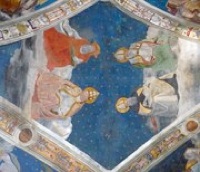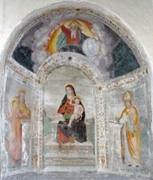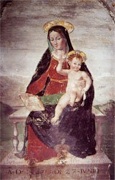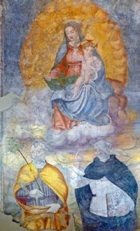

Lorenzo and Bartolomeo Torresani
The brothers Lorenzo and Bartolomeo Torresani were documented in 1523 at Sant’ Agostino, Narni (see below): this contract records that they came from Verona but that they were, at that point, resident in Narni. They enjoyed equivalent status in the contract, albeit that Lorenzo seems to have been the elder brother.
Lorenzo is more extensively documented in Narni that Bartolomeo. In 1522, the Priors of Narni asked Rinaldo Jacovetti to value an unspecified work by him. A document of 1537, which records a transaction undertaken by Lorenzo in Narni, reveals that he had married a widow called Perna Faccennetta, who had property in the city.
Lorenzo Torresani signed contracts for work in Rieti in 1524 and 1525. The brothers were again active in Rieti in the 1550s. They are documented in connection with the execution of frescoes (1552-4) of the Last Judgement in San Domenico, Rieti (search on Torresani).
Alessandro and Pierfrancesco Torresani
Alessandro and Pierfrancesco, the sons of Lorenzo, were documented as his associates in the contract for the frescoes (1552-4) at San Domenico, Rieti.
Narni
Frescoes (ca. 1523-38) in Sant’ Agostino

Doctors of the Church
In 1523, the Confraternita di San Sebastiano commissioned the fresco decoration of their chapel in Sant’ Agostino from Lorenzo and Bartolomeo Torresani. The contract records that they came from Verona and were, at that point, resident in Narni.
An inscription in the fresco in the 2nd bay on the right, which is written in a mixture of Umbrian and Venetian dialects, reads: “benché riccho di cor el Torresan Lorenzo veronese foi pur constreto per povertà lasar questa opera diserta onde ne ha dolar” (although rich in heart, Lorenzo Torresani of Verona was forced, through poverty, to leave this work unfinished, which caused him much regret). This is usually assumed to have been written by Bartolomeo after Lorenzo had ceased for some reason to be associated with the project. There was also apparently a date, 1538, inscribed on a candelabra depicted on the left wall.
The frescoes conform closely to the programme specified in the contract. However, the frescoes, which were covered in plaster at some point, are in a very poor condition. The best preserved is the fresco of the Doctors of the Church against a starry sky (illustrated above), which is in the large central field in the vaults.
Madonna and Child (1517)


This frescoes in a niche in San Giovenale (on the left of the right aisle, to the right of the apse) is attributed to Bartolomeo Torresani. The other frescoes in the niche, which seem to be by a different artist, depict:
-
✴God the Father above; and
-
✴SS Anselm and Mark to the sides.
[Dated by inscription?]
Madonna and Child with saints (ca. 1540)

Scenes from the Old and New Testaments (1570)
The Compagnia di San Giuseppe commissioned this documented fresco cycle from Alessandro Torresani for the walls of their new chapel (which also served as the sacristy) in San Francesco.



